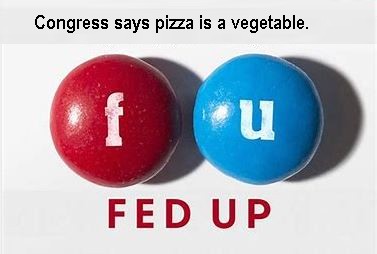- Animal versus Crop Agriculture
- Fish and Aqua-Culture
- GMOs – Genetically Modified Organisms
…… “Roundup Ready” – a promotional phrase
. - Inertia in the Food Chain.
- UN FAO: Livestock’s Long Shadow
- Sugar Addiction vs Veggie & Small Fish Diet.
……. EWG.org Guide to Good Food on a Budget
INTRODUCTION and BIOCAPACITY
View the section on BioCapacity before considering the challenges we have in providing Food for 7.5 billion people on the planet today.
.
.
ANIMAL VS CROP AGRICULTURE
The graphic below was created by the Environmental Working Group.org. It illustrates the cost of various food types as a function of carbon emissions.
Plant crops are far lower in carbon impact than animal agriculture. The correlation holds true for much of water use by agriculture type, but there are some differences. Nuts require a lot of water. Check the WATER page for the water needs of plants vs animals for food.
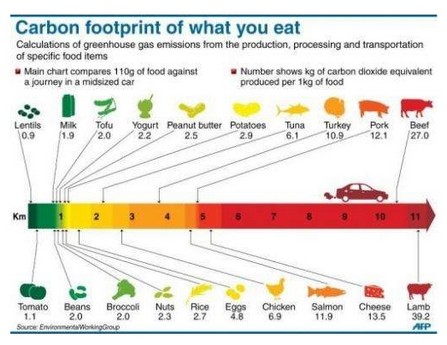
- Carbon from 110 grams of food is compared to carbon output for distance driven by an average car, ranging from 1 to 11 km.
- The number by each food icon shows the kilograms (Kg) of carbon dioxide generated for one Kg of food.
Here is another view, for equivalent driving distance vs 1 Kg of Food, rather than only 110 grams of Food:
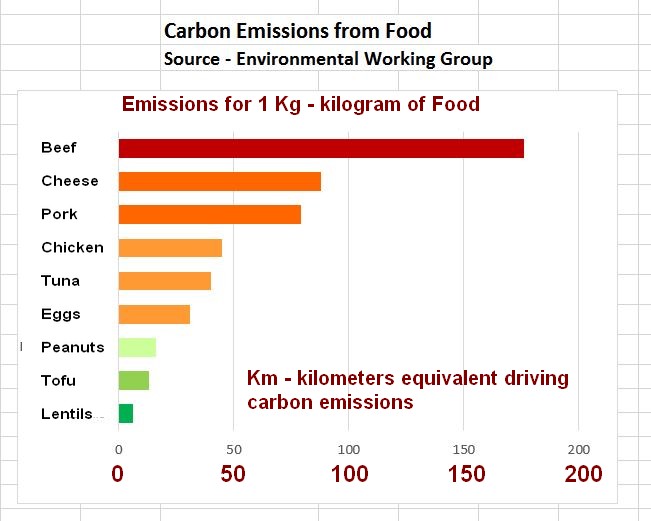
Cutting out Meat and Dairy
is the best way to reduce your environmental impact: study published in the journal Science, covered by CBC Radio.
”The researchers found that while meat and dairy products provide 18 % of all calories and 37 % of all protein, its production uses 83 % of farmland and produces 60 % of the agriculture industry’s greenhouse gas emissions.”

Half of the world’s seafood is produced by Aqua-Culture today!

Both Wild Fish capture and Aqua-Culture harvest are complicated subjects. You can look for “Pole and Line” caught fish, rather than dragnet fishing, which produces a high level of “By-Catch” – everything from dolphins to sea-turtles. Download the Monterey Bay Aquarium Seafood Watch summary, for guidance. The site has information on ocean issues and aqua-culture management also.
Look for labels on products certified to be sustainable, such as Marine Stewardship Council (MSC) and Aquaculture Stewardship Council (ASC) logos seen at www.SeaChoice.org. Other labels: Best Aquaculture Practices Certified, Ocean Wise, and Friend of the Sea.
Fascinating charts from the UN Food and Agriculture Organization, below. Half the world’s seafood is now farmed, in salt and fresh water. Controversy surrounds both caught fish and aquaculture, so imposing sustainability and having health conscious goals is important. Vote with your wallet.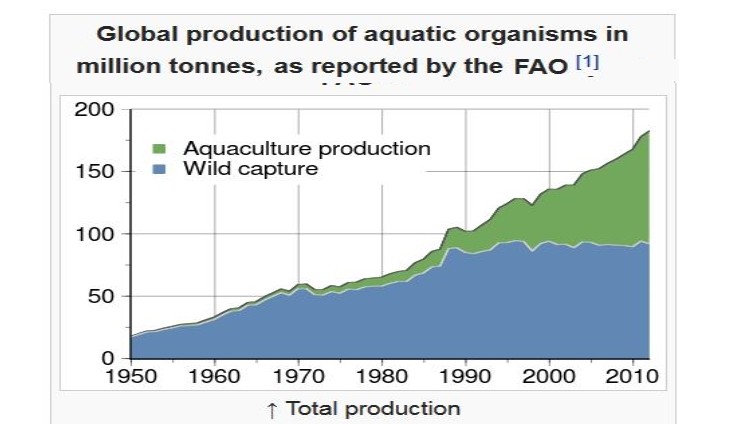
A breakdown of Seafood harvest by type of fish. Note the huge increase in Aqua-Culture output after the 1990s.
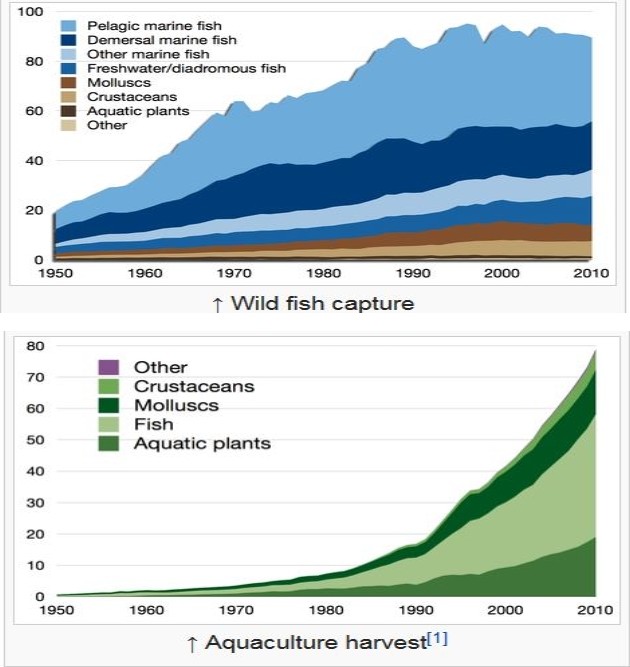
.
Halophytes – salt-tolerant crops
Foods of the future, as sea water invades coastal farm land.

GMOs – GENETICALLY MODIFIED ORGANISMS
….. Why are they of concern?
“Roundup Ready” – a promotional phrase
Let’s go right to the Source: MONSANTO – Roundup Ready Soybeans. At the Monsanto company site you can read all of the benefits, such as:
- “Today, over 60% of soybean acres in Eastern Canada are planted using the Roundup Ready system. And for good reason.” …. and …
- “Roundup Ready soybean varieties contain in-plant tolerance to Roundup® brand agricultural herbicides. Just spray over the top from emergence through flowering for unsurpassed weed control.“

So there you have it. The Monsanto Soybean crop is READY (through its GMO built-in plant tolerance) to be covered in a type of Monsanto weed poison (Roundup) and these Soybeans will survive nicely, while every other type of plant (weeds) will be controlled, namely, killed off. And then we, the consumers, eat all those Soybeans, complete with well-sprayed weed poison or herbicide, right from sprouting through flowering. Is there really any more to be said? Can’t say it any better than that.
Replace Soybeans with Canola, Corn, Sugarbeets and repeat.
While not recommended (an off-label use), many farmers spray Roundup liberally just before harvest. It works to dry out the crop and improve yield. One last coat before market.
Monsanto Roundup Cancer Trial Loss for $289,000,000.
A Californian school system groundskeeper, in the final stages of non-hodgkins lymphoma, with massive skin lesions, won his case against Monsanto / Bayer, Aug. 2018. Roundup was found to be a major contributor of the disease. Bayer is appealing the jury verdict. March 2019: In a second trial, the award was set at $80,000,000.
Potential for Seeds that are Infertile
Back to the Source, Monsanto. As of April 27, 2017, Monsanto reaffirmed its 1999 commitment not to sell “Terminator Seeds”, which are infertile and cannot be collected to grow a next generation of crops. If such seeds were sold, small landholder farms would then have no choice but to purchase seeds for new crops. See this Monsanto disclaimer webpage for their debunking of the Myth of selling terminator seeds. The technical ability exists to create terminator seeds and Monsanto owns the patents. The existence of this technology has continued to make people nervous, although it has not been used for two decades.
INERTIA in the FOOD CHAIN
The World Wildlife Foundation for Nature (WWF) has published an excellent analysis of the food chain, as part of their “2016 Living Planet Report”. (The link goes to a global footprint network.org resources page; scroll down to find the report). The impact of megafarms and food companies is highlighted:
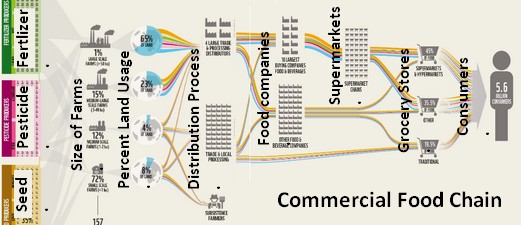
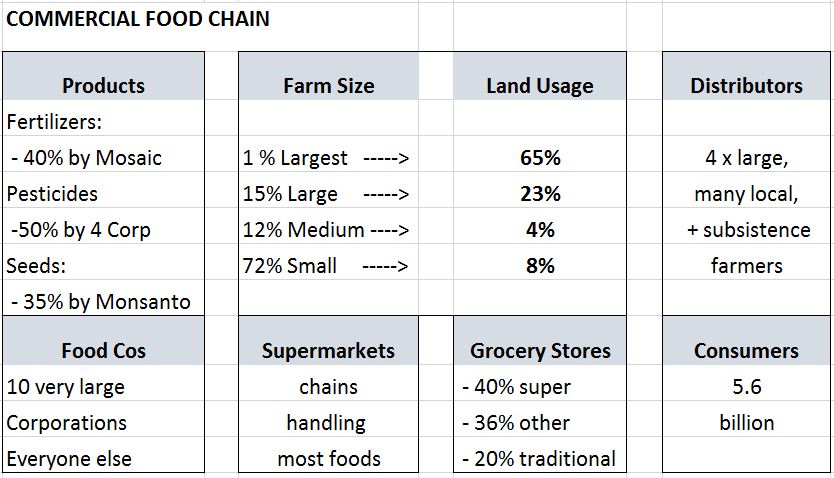
The world food chain is dominated by megacorporations, particularly farms, where the top 1% of farms cultivate 65% of all agricultaral land! The next 15% of medium to large farms use another 23% of growing land! The sheer size of these enterprises creates inertia, that is, a resistance to change.
Other factors making changes difficult (as learned from the report):
- 22% of farming business costs are subsidized by governments
- trade entrenches export crops for income in poorer countries
- 75% of soy bean production is for animal feed
- the real cost of agriculture is not reflected in food prices
and is not measured in terms of depletion of land and water
The notion that all 7 billion of the world’d people can be sustainably provided with a diet rich in meats is quite false. Land and water are already severly over-extended and the desire for protein continues to grow.
.
An agency working to restore sustainable agriculture, world-wide:
Institute for Agriculture and Trade Policy
Superbugs, from Animal Antibiotics
.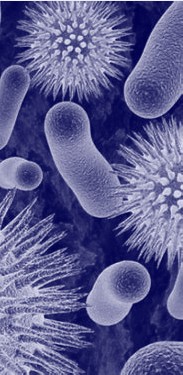 |
Just out: Environmental Working Group (EWG.org) has published this webpage: Supermarket Meat Still Superbugged, Federal Data Show”. Quote: “75% of the bacteria (the FDA) found on grocery store meat remains antibiotic resistant, as of 2015.” (To at least one of 14 primary antibiotics). Most grocery store meat is industrially farmed, packaged meat.
Industrial meat farms may be profitable, but they are inhumane. They use too many antibiotics, as a constant preventive measure against disease from crowding. Existing agricultural systems have been designed to maximize food production and profit, at the expense of long term sustainability and health. WWF recommends making food companies report on their environmental impacts. What gets measured get attention. |
Food already has “Organic” selections. Perhaps we should add “Certified Sustainable” to our daily food choices, especially meats. Consumers can drive industry in the right direction. Red meats also create 10x more carbon pollution, than a similar amount of protein from plants.
Return to the top
.
Report by FAO: “LIVESTOCK’S LONG SHADOW”
environmental issues and options, by FOOD AND AGRICULTURE ORGANIZATION (FAO) OF THE UNITED NATIONS (Rome, 2006)
The report examines the high impact of livestock on the environment, relative to other industies. At the same time, 990 million poor farmer’s depend on raising livestock for a living. Their well being must be considered in remedial actions. Recommendations are made for change to more sustainable livestock farming. An extract of some key findings is taken from the FAO Report conclusions:
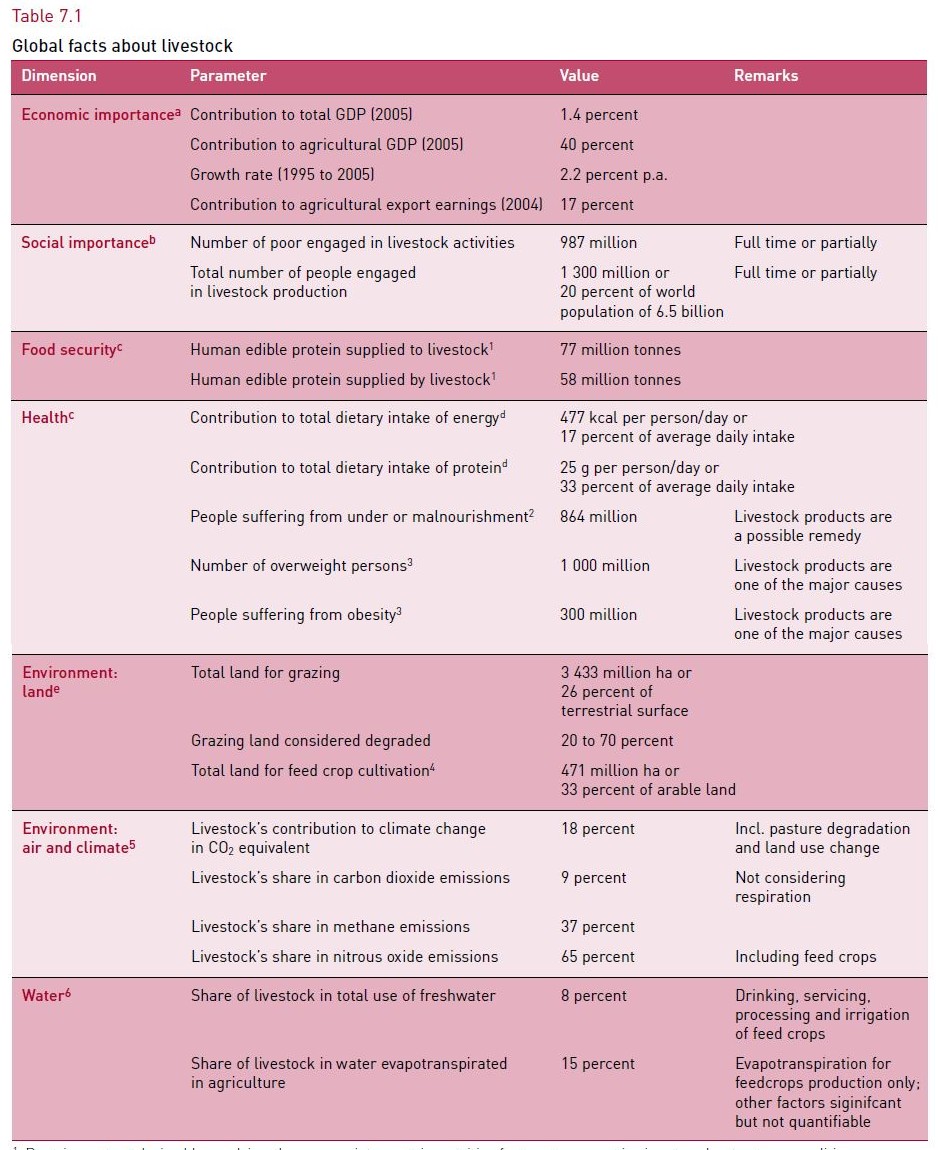
Download the full FAO report here or from the title.
Return to the top
.
Sugar Addiction versus a Veggie & Small Fish Diet
Here is your brain on cocaine: (or is that sugar?)
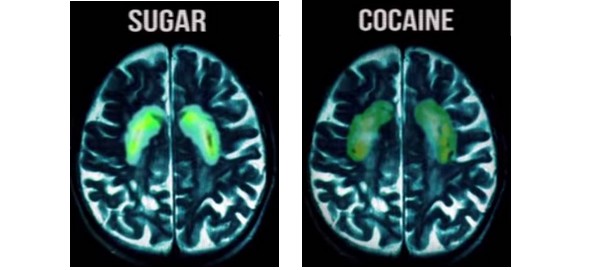
Sugar Addiction versus the Hybrid Paleo / Vegan Diet
A large focus of industrialized farming and food manufacture is the addition of sugar into 80% of packaged foods. It sells better. High fructose corn syrup is the low cost source of much of the sugar. Corn, soy, and cheese are foods subsidized in Big Agra. Studies indicate that sugar is highly addictive. Sugar spikes insulin, which stores fat. No amount of exercise can fight the fat produced by eating sugar. Brain scan images show similarity in the response to sugar and cocaine. Rats addicted to cocaine will give it up, to get sugar water.
Given the large rise in obesity, real food advocates, like Dr. Mark Hyman (*), are promoting a hybrid paleo / vegan diet, he calls “Pegan” (with a bit of humor). It centers on real food and avoidance of sugar and processed food. His advice – You can ask: “Is it a raw fruit, vegetable, or a piece of fish, or is it a processed food in a package, with added sugar?”
Dr. Hyman’s website offers information and tools for low cost and low effort shopping, cooking and eating of real foods, including meats. (* Rescue The World.net has no commercial connection to that site.)
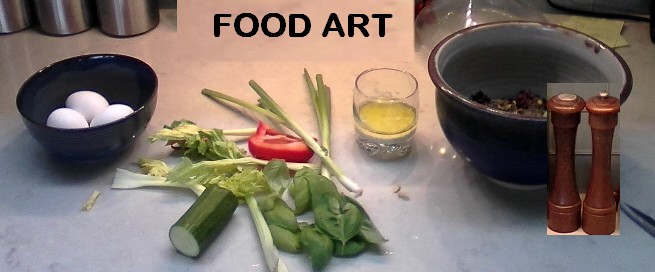
Eat real food.
.
Fast Food Subsidies in most US Schools
Real food vs processed, sugary food, is also the subject of “Fed Up”, a movie on Netflix. It shows fast food brands (burgers, pizza, fries, sodas, nachos and cheese) served in the majority of US school lunchrooms, subsidized by Coke and Pepsi. (Pizza with tomato sauce and fries are classified as “vegetables”.) Wow – that’s shocking!!!
Official website for the movie FED UP
.
Environmental Working Group – Real Food Guide
EWG.org has produced a helpful guide called: “Good Food on a Tight Budget”, which suggests the lowest cost and best quality protein and vegetable items to replace processed foods. The download asks for a donation (but that is optional). Just enter an email address to get a free download link by email.

The Veggie and Small Fish Diet
or Pescatarian Diet
This is basically the Pegan diet (paleo / vegan), without meat and with limited dairy. Fish has lower enviro impact than meat. There is more sustainable seafood available today than meats, and some are wild caught: wild salmon, sardines, makerel. Insect, algae and yeast proteins are a new horizon.
- No sugar; it is addictive and causes more sugar cravings. Sugar spikes insulin, which stores fat. Sugar is an “empty calorie”, lacking nutrition.
- Real protein with every meal: Fish, shellfish, nuts, seeds, eggs, cricket powder, spirolina and nutritional yeast are best, followed by lentils, beans, other legumes or even mushrooms.
- Real vegetables 10 times a day (including 2 – 3 fruits): Chard, spinach, kale, broccoli, carrots, fresh tomatoes, peppers, salad, ‘shrooms, celery, onion, cauliflower, cabbage, eggplant, yams, …
- Frozen veggies (without sauces) are a good second choice
and are starting to taste like the original - No wheat or refined grains. Limit white rice, pasta, starchy potatoes
(no fries). Some black rice, quinoa. Cauli and cabbage as fillers
- No processed foods, like cookies, snacks, chips, candy, juice, cereals, canned soups or other pre-cooked meals, soda drinks, …
- Only good oils: fish for omega-3, olive oil, avocado, nuts, some butter. Oils to avoid: processed canola, soy oil, corn oil, margarine, coconut oil, fatty skins or meats, deep fried food, cheese.

Please do not addict babies to sugar.
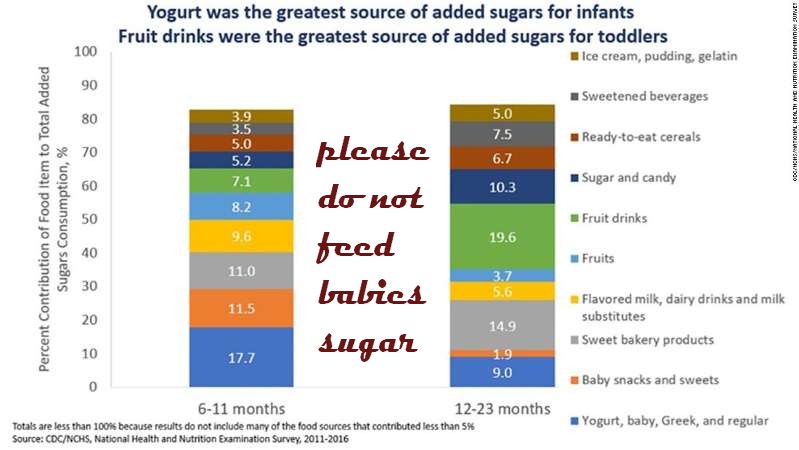
World Resources Institute
– Analysis on US Diet and Greenhouse Gas Emissions – GHGs
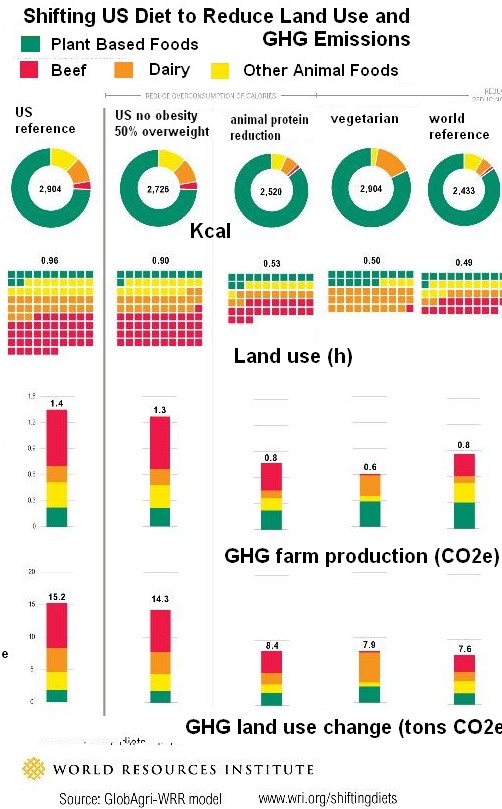
Source:
World Resources Institute
– Analysis on US Diet and Greenhouse Gas Emissions – GHGs
US Life Expectancy Losing Ground
– due to poor diets and inadequate health care coverage
.
Other Reading:
An Eco-Diet can be Excellent for Health too

Trends in Food Production Capacity:
2050 Projections
per the UN Food and Agriculture Organization – FAO
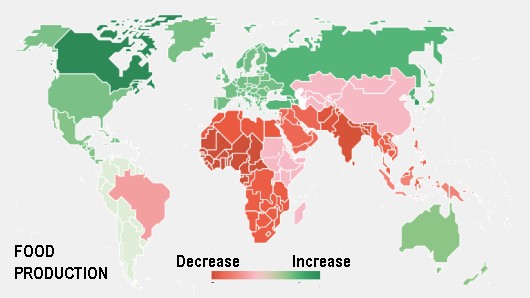
There is a reverse correlation to population growth in many of these regions, particularly Africa and southern Asia. While Canada and Australia are projected to grow more fertile, both are already experiencing extreme weather, which make agriculture unpredictable.
Post GMO Food Economy
In an article at MordernFarmer.com:
The economic case is made for conventional corn seed rather than GMO corn seed (genetically modified organism corn seed). As weed resistance adapts, and pests adapt, GMO crop farmers can no longer avoid using herbicides and pesticides, leveling the playing field with conventional seed types. The cost of planting an acre of corn are seen in this graphic from the article. The high cost of fertilizer is shown too. Using alternates to high phosphate fertilizers might be attractive.
_______
.





